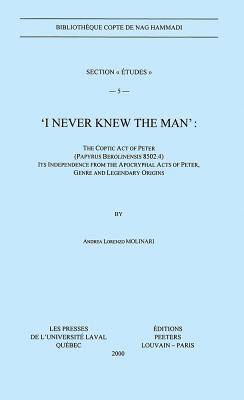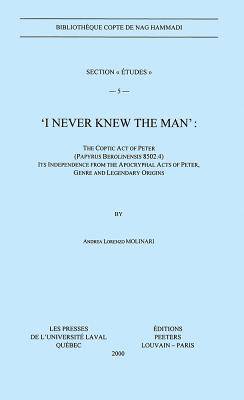
- Afhalen na 1 uur in een winkel met voorraad
- Gratis thuislevering in België vanaf € 30
- Ruim aanbod met 7 miljoen producten
- Afhalen na 1 uur in een winkel met voorraad
- Gratis thuislevering in België vanaf € 30
- Ruim aanbod met 7 miljoen producten
Zoeken
I Never Knew the Man
The Coptic Act of Peter (Papyrus Berolinensis 8502.4), Its Independence from the Apocryphal Acts of Peter, Genre and Legendary Origins
Andrea Lorenzo Molinari
Paperback | Engels
€ 127,45
+ 254 punten
Omschrijving
The Act of Peter, Papyrus Berolinensis 8502.4 was discovered in Egypt some years before the end of the 19th century and subsequently published in 1903 by Carl Schmidt. Since Schmidt's study, much of the overall debate has centered on this text's relationship with the apocryphal Acts of Peter (preserved in the Latin manuscript, Actus Vercellenses). Schmidt viewed the Act of Peter as part of the long-lost first third of the Acts of Peter, a position which has since attained general acceptance. Molinari contends that scholars have been hasty in their acceptance of Schmidt's position, which under scrutiny reveals itself to be built on assumptions that are tenuous at best. Molinari makes his argument in two parts. The first part refutes Schmidt's theory that the Act of Peter was originally part of the Acts of Peter. The second part discusses the issue of genre and origins.
Specificaties
Betrokkenen
- Auteur(s):
- Uitgeverij:
Inhoud
- Aantal bladzijden:
- 214
- Taal:
- Engels
Eigenschappen
- Productcode (EAN):
- 9789042909724
- Verschijningsdatum:
- 31/12/2000
- Uitvoering:
- Paperback
- Formaat:
- Trade paperback (VS)
- Afmetingen:
- 160 mm x 239 mm
- Gewicht:
- 340 g

Alleen bij Standaard Boekhandel
+ 254 punten op je klantenkaart van Standaard Boekhandel
Beoordelingen
We publiceren alleen reviews die voldoen aan de voorwaarden voor reviews. Bekijk onze voorwaarden voor reviews.








